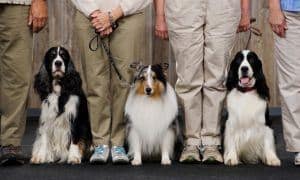“This post contains affiliate links, and I will be compensated if you make a purchase after clicking on my links.”
There’s no doubt we’ve all heard of dog shows, and have probably seen one on television. You don’t have to have a purebred show dog to enjoy dog shows. They can be fun to watch on television and especially fun to attend. Healthy Dog U gives us this spectator’s guide to dog shows, so we can all watch and follow along:
A Spectator’s Guide to Dog Shows
You don’t have to be an owner of a purebred show dog to enjoy dog shows. These events are fun for any pet lover to watch in person or on television. Here is a breakdown of all you need to know so you and your pup can follow along.
WHAT IS A DOG SHOW?
The most popular type of dog show is an all-breed conformation show— in which purebred dogs are judged for how well they conform to the American Kennel Club’s (AKC) breed characteristics. This in-depth set of standards ranges from weight and color to gait and personality.
Each competitor is placed into one of seven classes, depending on age and experience, among other factors, and the male and female dogs compete separately within each class. The dog and handler jog around the ring in front of the judge, and the judge examines each animal’s appearance. During this time, the dog is expected to be calm and well-behaved; attempting to bite will lead to disqualification.
Prizes are awarded for first through fourth place within each class and sex. Then, the male and female winners compete against each other and all participating champion dogs for the title “best of breed.” Next, these winners compete for best in group (e.g., sporting, terrier, toy), then for best in show. Each award comes with championship points, which can affect the class in which the dog competes at the next show.
WHY DO BREED STANDARDS MATTER?
To the skeptical, dog shows may seem like an unhealthy obsession with appearances. But breed standards are more about function than form. “Breed standards aren’t in place just to make a dog look nice,” explains Carolyn Nestor, a Yorkshire terrier breeder in Harrisburg, Pennsylvania, and a member of the Yorkshire Terrier Club of America. “If you look at the heritage of each breed, these dogs were bred for a certain function; breed standards maintain those characteristics.”
She explains that, for instance, Yorkshire terriers were bred to be ratters in tiny spaces, so their small size and willful personalities allow them to complete that task.
WHY SHOULD I ATTEND A SHOW?
Dog shows are fun to enjoy on television in the comfort of your own home, but there are many benefits to seeing the show first-hand:
Get advice. Exhibitors have usually been breeding and showing dogs for many years, so they are excellent resources for grooming tips and general information about the breed. If you’re interested in adopting a purebred dog, it is extremely helpful to first attend a dog show and mingle with breeders. They will advise you on whether that type of dog is appropriate for your lifestyle and may also be able to recommend shelters, groomers, and veterinarians. Note: If you plan to adopt a purebred dog from a breeder rather than a shelter, make sure that the breeder is endorsed by the AKC, as these breeders are required to breed for good health and temperament.
See unusual breeds. How often do you get to see a dog covered with floor-length dreadlocks or pups that are completely bald except for a sprout of perfectly coifed hair around the face? Komondors and Chinese cresteds are only two of the many unique dog breeds you’ll see, en masse, at a dog show. Some shows even have a Meet the Breeds program, which allows you to get up close and personal with the competitors and their owners after judging.
Shop and learn. If you only have eyes for your own pets, you can still find entertainment at dog shows. Beyond the rings is a wide array of booths selling books; handmade clothes, collars, and leashes; and pet treats, among other items. Also, representatives from major pet food companies are usually available to answer your questions about pet food and nutrition.
WHAT DO I NEED TO KNOW ABOUT BEING A SPECTATOR?
Going to a dog show promises a fun time for adults and children alike; however, it is a serious event for those whose dogs are in the show. Follow these basic rules of etiquette to make sure that your fun doesn’t interfere with the competition:
Don’t…
. . . pet a dog without asking. With so many adorable dogs around you, it can be difficult to resist scratching their heads and giving them kisses. But handlers have spent hours grooming these dogs to perfection, so always ask for permission before touching an animal, and don’t be offended if the answer is a polite “no.” When the dog has completed showing, handlers are usually more than happy to let their pups accept a pat.
. . . ask handlers questions before they’ve completed showing. Handlers and breeders are often extremely busy preparing their dogs and themselves to show. From grooming to getting to the correct ring in time to keeping the dog from becoming distracted, these professionals have a lot to think about. When they’re out of the ring, however, feel free to go over and ask questions; most are very friendly and happy to offer advice.
. . . bring your pet to the show. You may be excited to introduce your dog to other dogs of the same breed, but most shows have strict rules against spectator dogs. Even the most perfectly behaved pet can become overwhelmed at a show and be a distraction to competitors.
Do…
. . . wear comfortable shoes. Dog shows are held in big spaces with hard, concrete floors (that can withstand thousands of dogs’ worth of slobber and potty accidents), and you may find yourself walking long distances.
. . . purchase a catalog. Usually available for a small fee at the entrance, these books help spectators follow along with a list of dogs competing (arranged by breed and class) and the judging time and ring number of each breed.
. . . have a great time! If you’re a true dog lover, attending a dog show can be an educational and exciting time. You will have the opportunity to meet leading experts in dog care and health and to learn everything you need to know about keeping your own pet looking and feeling her best.
WHAT HAPPENS NEXT?
Some may worry about the lives show dogs have once they’ve gone as far as they can go in the ring. The truth is that retired champions enjoy spending the day with their owners and just being a dog. Some may go on to stud or whelp puppies, while others use their polite ring manners to benefit those in need.
For instance, since Uno’s triumphant win a little over a year ago, he’s become certified as a therapy dog, using his loving, dog-next-door demeanor to brighten the day of sick and elderly people. Looks like the Red Baron has finally met his match.
Show Slang
Here is a rundown of basic dog show lingo:
Best of Opposite—The title given to a dog who is the best of the opposite sex of the dog named best of breed
Champion—A dog who has earned at least 15 points, including two majors from two separate judges (Champions compete in their own class.)
Gait—The way the dog moves around the ring
Handler—The person (owner, breeder, or professional handler) who walks the dog around the ring
Major—A win that earns the dog at least three points
Winner’s Dog/Winner’s Bitch—The male and female dog, respectively, who is named the best of their sex of all classes (These dogs compete against each other and the champions for best of breed.)
You can read the rest of the spectator’s guide to dog shows here. Do you think going to a dog show sounds like fun? Have you ever entered your dog in a show? Tell us about it in the comments below!



















Cody
Nov 25, 2013 at 6:41 pm
I am curious to find out what blog system you happen to be working
with? I’m experiencing some minor security issues with my latest site
and I’d like to find something more safe. Do you have any solutions?